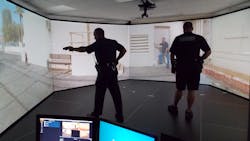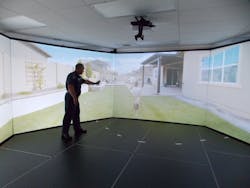Dogs are a part of many people’s lives. They are companions, best friends and a part of the family. But in the end, while domesticated, they are still animals. When their instincts kick in, it can be a recipe for disaster if one comes face to face with a law enforcement officer.
Within the last decade, there have been several high-profile incidents involving canines and responding officers. A dog was shot and killed by an officer in Commerce City, Colorado in 2012. The city settled with the dog’s owner for $262,500 in 2016. That amount has gone up over time. In 2019 in St. Louis County, Missouri, a settlement was made for $750,000 in the fatal shooting of a dog that took place in 2014.
In response to those incidents, the Law Enforcement Dog Encounters Training program (LEDET) was developed by VirTra in partnership with the National Law Enforcement Center on Animal Abuse (NLECAA) and the National Sheriff’s Association (NSA).
OFFICER Magazine recently spoke with Jim Crosby, a recognized authority and court accepted expert on canine attacks and aggression who helped develop the training, and Lon Bartel, the Director of Training and Curriculum at VirTra.Addressing the problem
Crosby’s career in law enforcement spanned 22 years and he retired as a lieutenant with the Jacksonville Sheriff’s Office in Florida. He spent all of his career in patrol and describes himself as “a street cop from way back.” He joined the department at the age of 19 and retired when he was 41. In retirement, he pursued a much different career in dog training and behavior. In 2014, when it became apparent that officers were having issues with dog encounters, he began researching the issue and looked at both the behavior of the dogs and the actions of the officers.
Having expertise in both reviewing use of force as a commanding officer and as a canine behavioral specialist, he was well-equipped to tackle this emerging issue. In 2015, the California POST reached out to a group of trainers, including Crosby, and brought them to Southern California. That group helped produce the first training course certified by California POST for law enforcement encounters with dogs.
He says the training was aimed at “keeping officers safe, keeping the pets safe and, also, not only keeping the public safe, but avoided what was turning into some very contentious issues between police and their communities.”
Crosby wanted to create an even more comprehensive course on a national level and did that with the support of the National Sheriff’s Association and VirTra. “It was time to step in and produce something to try to help the officers make good decisions and help themselves and also protect themselves from liability,” he says. In both Commerce City and St. Louis County, the officers were stripped of qualified immunity. While the officers themselves were not the target of lawsuits, Crosby warns that the exposure is there. “That new minivan your wife wants? That new bass boat that you’d like? Those toys you would like to get your kids? The private school? If you make the wrong decision, you’re going to be paying a dog owner and working extra jobs for the rest of your career.”
Bartel says that when VirTra became involved in the program, it was obvious that something needed to be done. “We’ve got to understand that sometimes the dogs are just doing the dog’s thing and unfortunately, it may be what the officer thought was the only option they had, but sometimes maybe it was just a misidentification of the behaviors,” he says. “Everybody wants to tie the financial component to it and say there is this settlement or that settlement, but let’s look at the reality. We love our pets. People get very attached to their animals and, depending on why the law enforcement agency was there, losing a pet is a horrible, tragic thing.”Creating the program
With Crosby on board as the animal behavioral expert, VirTra created the video component of the program and provided him with a full-sized training module. He’s been presenting the course across the country for over a year now. “For a lot of officers, they don’t know what to look at in the dog’s behavior and they don’t know how to interpret it,” says Bartel.
The program is based on the “Basics of Behavior,” which highlight where attention needs to be spent. “The reality is that we have a limited resource of attention. You can’t pay attention to a ton of stuff,” he says. “You can’t pay attention to everything all at once, and if you pay attention to one thing, you do so at the occlusion of a bunch of other stuff… What we did is show where you need to put that spotlight of attention and what it means.”
The program is broken down into specific scenarios such as Domestic Violence Response, Public Risk and Unconscious Person. “Think of it as a live role-play event that happens within the simulator where you have an environment that is presented,” says Bartel. “Within that environment I might have actors, along with dogs, that are portraying various behaviors. Then you have to look at and interpret what it is and take the proper course of action.”
With the single-screen simulator, Crosby is able to visit agencies across the country and show them the material in a live one-to-one representation so that the students are seeing the dogs in their actual size.
While VirTra has created scenarios that have included dogs in the past, none have focused the training around the dogs themselves. “I’ve never seen anything like this done and have never done anything to this extreme inside of a law enforcement setting with canines,” says Bartel. “It was absolutely groundbreaking. There were a lot of things we needed to figure out to make the magic work and I think the team did an amazing job.”
He says that after Crosby presents the class, the agency can go back and host refresher courses for its officers. “If you don’t use it, you lose it. We built it so it can be done in small blocks. I’m not tying up an entire patrol shift for a day; I’m bringing folks in for about 15 minutes as a refresher and sending them on their way.”Transferable training
An interesting aspect of the training, Crosby points out, is that officers don’t have to be taught anything they don’t already know how to do. “Having spent so many years on the street, I know what our normal procedures are, what you can do, what you normally do,” he says. “So, one of the ideas of the training is that we take those tools and techniques the officers already have and teach them how to apply it with a dog. They don’t have to learn a whole lot of new stuff.”
For instance, he says that moving your body into the bladed shield investigations stance that been used by law enforcement for over 40 years is also a de-escalation signal to a dog. If a dog is presenting a challenging, you don’t want to face the animal straight on because a dog sees it as a challenge. When a dog wants to de-escalate a challenge with another dog, they turn their body or gaze slightly to the side and they turn their head slightly to the side.
“There is this technique we all know, we already do instinctively when facing off with humans and it can help us de-escalate a dog conflict. That kind of stuff; it’s a matter of educating them how these things we already do apply to encounters with dogs,” he says. “They know the skills, they just don’t understand how easily and how readily they can apply those same skills they already know to dealing with dog issues. Nobody’s ever told them that. Once you explain it to them, it’s definitely ‘Oh, I get that now.’ ”
He says that a lot of the techniques—like the bladed stance—if the situation is going to go sideways, it also puts the officer in a good position to be able to defensively respond just like with a human suspect. “You turn your body so your primary sidearm side is away from the suspect, or in this case the dog,” he says. “You’re getting ready for action. You’re thinking through strategies of how to use everything on the scale of force that we all already know is applicable. You’re going from presence to verbal commands to less-lethal and non-lethal to the use of deadly force and when that is appropriate and how to recognize those situations.”
Crosby says that the goal is to apply what officers already know and having it translate into dealing with a situation that is not all that different.
Adoption of training
Crosby says that there are now more law enforcement agencies training for dog encounters, because there once were none. Like in so many cases, the training usually ends up being adopted after a department is involved in a situation where a lawsuit was filed or a settlement was made.
“There’s so much training and information the guys need to get through the day anymore that it almost has to be that way because there is limited training hours and limited resources for training. It’s understandable why it’s gotten that way,” he says, but adds that this type of training isn’t cost-prohibitive since no specialized equipment is needed for training—though catchpoles and leashes can come in handy when confronted by a canine.
According to Crosby, in the course of American policing history, there have only been seven police officers who died as a result of a conflict with a dog. One died several years ago from an allergic reaction to the rabies vacation. The other six died prior to 1932. None of them died from a catastrophic medical event due to a violent attack.
“People kill us a hell of a lot more than dogs do,” he says. “I’d like to see it included in all academy classes. Of course, update training to all existing officers. Especially using it as a component of the human de-escalation training that is going on right now with quarterly or yearly firearms training. It can be wrapped into that. It can also be something that is presented in two- or three-minute bytes during roll call training, just to keep the ideas at the front of the officers’ minds.”






